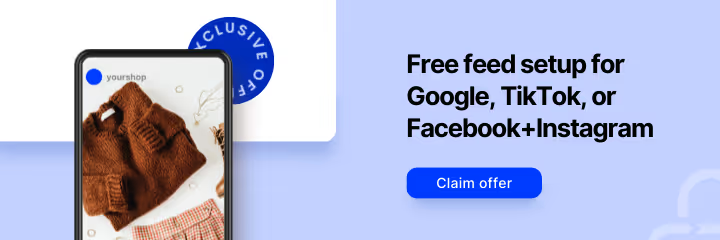Welcome to your first month at GoDataFeed. We want to make sure you have all the resources you need to start using our software.
We also want to make sure you understand the importance feed management plays in the success of your feeds. Failed feed imports, validation errors, and disapproved feeds are just some examples of the problems you’ll face while setting up. These issues can be intimidating, but we are going to show you how to solve them one by one. Starting with the disparity between data on platforms versus data on channels.
The delicate balance between platforms and channels
Ecommerce platforms use static data structures to store values for thousands of products at time so it can be retrieved for use within their web stores. Despite all of this data, ecommerce channels still need more. Channels like Google, eBay, or Amazon have much different standards for data intake than platforms like Shopify, BigCommerce, and Magento have for data output, leading to incomplete data sets.

The incomplete data sets lead to errors in the feeds, and the merchant is stuck dealing with them. Some common errors include:
- Price and sale price being flipped in Google Merchant Center.
- The name of values changes, so it gets mapped incorrectly.
- Needing a specific content API to upload product feeds from Magento.
- Strict inventory expectations from Amazon, requiring constant stock management.
- Facebook ecommerce manager not reading data file URLs due to the header.
- Wrong taxonomy or NO taxonomy in a marketplace feed.
- Missing GTIN or other universal ID.
All of this extra information the channels need is used for product syndication. Once the channel has indexed your catalog, they categorize the products so it can show up based on matching search queries. The product data must be as detailed as possible so that any potential shopper can have a sense of what is being sold.
Creating a seamless flow of healthy product data
GoDataFeed resolves the differences between how ecommerce platform's structure product data and how channels consume it. However, If you do not opt for our fully managed service, the responsibility of setting it up for success falls on you.
Getting your feeds up and running is one thing, but harnessing the entirety of GoDataFeed’s arsenal to maximize your campaign’s profitability is completely different. We don’t just want you to just use our app to deliver your products across channels. We want to supercharge every single one of your marketing efforts with kickass product data.
So how does GoDataFeed solve the disconnect between ecommerce platforms and ecommerce channels?
The first and most important way is by collecting all of your data into one catalog. We centralize your data across platforms so that it can be collected into a central database, then used however you see fit.
Now that it is all in one place, we can make all of the value's uniform for whatever channel you want. This allows for any missing data to be added so that your catalog is optimized for the channel. For example, if you are selling on Google, a commonly missed value is GTIN. In this case, we will go in and either fill this data from the catalog or replace it with MPN or Product ID.
After standardizing values for channels, we now give you the ability to enhance and optimize this data. Now, there is a long list of optimizations that can be done to your product feeds, our favorites have to do with the rules that can be set up. Like calculator functions or automatically removing promotional language.
The last way that we ensure the continual connection between platforms and channels is through the fluidity of information. Our feed service automatically checks for updates to your storefront at a custom time each day. This allows for the free travel of information between your storefront and your feeds. So that your products are always as up to date as they can be.
Maximizing your first 30 days with GoDataFeed
Now that we've seen the problems retailers face and how GoDataFeed solves them, let's create an actionable plan for your first 30 days with our software to set you up for lasting success, the first time around. We've created a schedule that includes mandatory practices (plus tips & tricks) that will make the entire process perfectly clear.
Day 1
Import your product data from your primary source. This can either be from a product file via an HTTP link or an FTP, or it can be from an ecommerce platform. We have integrations with most ecommerce platforms, so that you can easily import your product catalog into our system.

This may be supplemented as well with additional product data or attributes in the form of merge files. After all of that has been taken care of, we recommend setting up a platform tour with our account managers. They will take you through our service and answer any and all questions you may have.
With the newly acquired knowledge pushing you forward, now is the time to customize your product catalog so that it works for you.

The steps to optimizing your catalog can seem complicated but are simpler than you might think.
- After the primary source and merge files are imported you can download the product catalog and go through it to see if there are any missing attributes or products. Always double check your catalog.
- Your product catalog is automatically mapped to fields within our database. Make sure to parse these to make sure they are all accurate to the data described and its content.
- The import filter ability allows you to create rules to exclude certain products from being imported into your GoDataFeed product catalog. This is useful for when you need to exclude certain products from the source feed from individual catalogs.
- Allotment is the number of SKUs that you are allowed to import at once. Make sure to adjust this so that you are not leaving out any SKUs from being imported.
- The final step is to schedule the automatic product import. This is the number of times GoDataFeed updates your product catalog if you change anything in the source data. You can customize the import to check as many times as possible a day, whenever you want. Although the default is once at 12 AM.
Week 1
Time to start thinking about channel feeds. There are so many different channels to choose from and it can be hard to decide between paying to advertise (PPC) vs. paying to sell (Marketplace). Before that, our account managers will set up your first PPC feed for absolutely free. This can be redeemed once after setting up your product catalog. Request your free feed setup right here.
It takes our feed specialists 2-4 business days max to complete your first feed setup for you. Once complete, the feed specialist will send you instructions to review the feed, and they can assist you with any additional adjustments you need done to the feed.
Now that you have your channel, let’s optimize its product feed.

- Mapping: This is different from the mapping done on the import because each channel might have different values specific to themselves. So, it’s important to map values carefully and with as much accuracy as possible.
- Filters & Exclusions: Removes SKUs from channel feeds.
- Categories: This is for channels like Amazon that have product categories that will help your products be organized into their correct places.
- Custom Rules: Rules allow you to apply logic to your product data to update or modify field attributes, add third-party tracking, replace text in your data, calculate number values and generally improve product listing quality.
- Validation: Every time you compile your feed, it checks the data quality of your feed and shows you things you can improve based on completeness, channel readiness, and optimizations.
- Write File: Every time a feed is compiled it also creates a folder that contains a copy of your feed. We recommend checking it to find errors.
You should also be aware of the specific requirements each channel has for their product feeds. Save yourself a headache, research channel requirements.
With GoDataFeed you can clone and create as many feeds as you like, provided you have the marketing budget. Every feed setup after your first one diversifies your catalog of products, increases brand awareness, and puts your products in front of more potential customers. We can do it for you for just $99, or you can do it yourself by following the instructions in our help desk. However, be careful of stretching yourself too thin.
It’s important to mention we occasionally send emails containing customer perks, rewards, and more. These can contain anything from a small discount due to continued loyalty, all the way to an additional feed setup for absolutely free. Make sure to subscribe to our emails to receive updates and industry insights, as well as a chance to win some awesome rewards.
Week 2 and 3

You are now well on your way to optimized feeds. Going into your second and third week, now well acquainted with your feeds, you should now focus more on monitoring and troubleshooting rather than development.
At this stage the validation summary becomes all-important. You’ve already dealt with it when you were fixing error messages to get your feed published. Now you take a step back and cover the optional, yet still important, messages.
There are two types of messages left: warning vs info. Each with their own important details. Warning messages focus on the non-critical yet important data. These won’t stop your feed from being published yet are recommended. Info messages are completely optional changes that are small optimizations that can help with sales, discoverability, etc.
Warning messages are recommendations like “add product type” or warnings for future non-compliance like “GTIN is invalid”. While info messages look like “descriptions may benefit from more details” or “custom labels can help classify products”.
Week 4

The fourth and final week of your beginning with GoDataFeed. The last step is to analyze and learn how to track and test your feeds and products to constantly stay on top of their performance.
The best way to get to the bottom of your feeds is to measure the Key Performance Indicators (KPI’s) within whatever channel you want to track. For organic metrics this includes Click-Through-Rate (CTR), conversion rate, average order value, etc. For paid metrics we would look at Cost-Per-Click (CPC), Cost-Per-Acquisition (CPA), Return on Ad Spend (ROAS), and more.
What you should be looking for with these KPIs, as well as the channel feed diagnostics, is the performance quality of your feeds based upon how people are responding to your products. Seek out the products that are in the top 10% in terms of performance and see why those are generating more sales than others, and then copy it for the rest of your catalog.
Try out these newfound theories within improvised A/B tests. Change one value on one product while changing the same value on a different product the opposite way (i.e., more vs less additional images, more descriptive vs less descriptive titles, etc.)
Performing this audit of your feeds is the perfect cap to your last week as a beginner at feed management. Because as soon as you master the analysis and testing of feeds, you can no longer be called a beginner.
Resources

Our help center is filled with informational content that can help people of any experience level through almost any situation. For those with a firm DIY mindset, this is for you.
Not just feed management, it answers every single question you could ask about imports, exports, catalogs, feeds, channels, orders, and on and on. And if you can’t find it there, check out our blog or our channel guides. We cover lots of leading industry topics that we are sure will help.
Finally, if you ever feel like the complex problems of feed management are starting to weigh you down, or you would rather just have us take care of your products for you. There is another option for you. We offer fully managed feed services, where our account managers fully optimize and monitor your product catalog so that you don’t have to.
Wrapping up:
No one knows your data quite like you do, we pride ourselves on being a user-friendly, DIY platform. That’s why we offer our all-in-one feed setup overview guides and posts so that you can fix your own feeds, your own way. However, we also know how hard it can be to manage it all at once, which is why we offer the first PPC feed setup for free, as well as our fully managed services.
No one has ever become an expert overnight. Be sure to take breaks and allow your feeds to breathe whenever possible. If there are any more questions or concerns. Do not hesitate to reach out to our support team, they will help however they can. We wish you all the success possible with your feeds!






%20).webp)